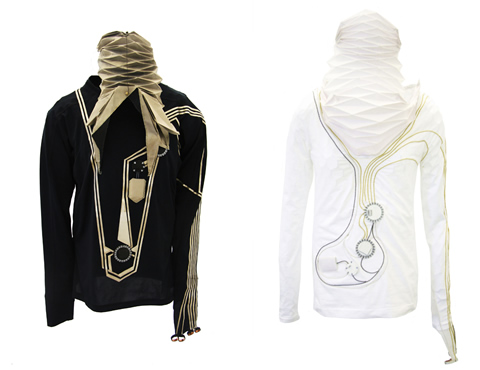What if you could buy a shirt that not only looked smart but actually was smart?
Researchers in the field of responsive architecture have made a prototype of an “intelligent shirt,” capable of detecting potential infection risks, and taking defensive measures against them.
The shirt monitors the wearer’s vital signs, as well as their immediate surroundings. If the wearer develops a fever, or the environment becomes toxic, the shirt extends its collar into a face mask that, through its multiple folds, enhances the performance of the latest filtration technologies.
Part medical device and part fashion statement, the mask balances form and function – a goal common to both fashion and building design.
“Clothing and architecture have a traditional alliance,” says Carol Moukheiber, a co-founder of U of T’s Responsive Architecture at Daniels (RAD) Lab, who worked with graduate student Stacie Vos on the intelligent shirt. This project treats clothing as a “micro-environment,” bringing the principles of architecture close to the body.
“Clothing becomes an extension of the skin, and architecture becomes an extension of the clothing,” she says.
The intelligent shirt was inspired by a challenge of modern airport design, which is to move people from place to place as quickly as possible, while also preventing travelers from spreading pathogens. Channeling passengers through scanners and other sickness-prevention checks is costly and time-consuming.
It appears to be much more effective to design for the “micro-environment” of each individual traveler, and to use computer analysis to automatically deal with infection risks.
While the shirt speaks to the specific challenges of airports, it also raises bigger philosophical questions.
“This was a speculative project,” Moukheiber says. “We asked, ‘What happens when an object – a building, an article of clothing – gains an IP address?’ What happens when you give that object primitive cognitive capacity?’”
A single intelligent shirt can protect its wearer, but if millions of people adopt them, they could become a vast data collection network, allowing epidemiologists to track the spread of disease around the world in real time.
This scenario comes from a technology that is still in its infancy.
“Over the past couple of decades, there has been an increasing miniaturization and affordability of sensors and microcontrollers ,” Moukheiber says.
As researchers experiment more with bestowing sensors and Internet connections on everything from road signs to toasters, the intelligent shirt becomes part of a larger context – a smart network of formerly inanimate objects.
In that context, there is no telling how far the “extension of the skin” might actually go.
Recent Posts
People Worry That AI Will Replace Workers. But It Could Make Some More Productive
These scholars say artificial intelligence could help reduce income inequality
A Sentinel for Global Health
AI is promising a better – and faster – way to monitor the world for emerging medical threats
The Age of Deception
AI is generating a disinformation arms race. The window to stop it may be closing






